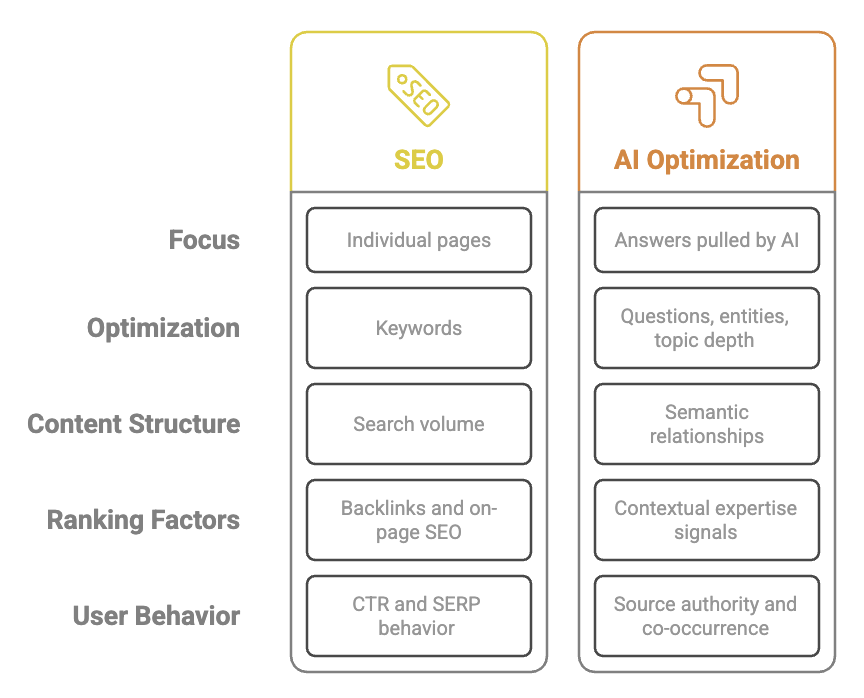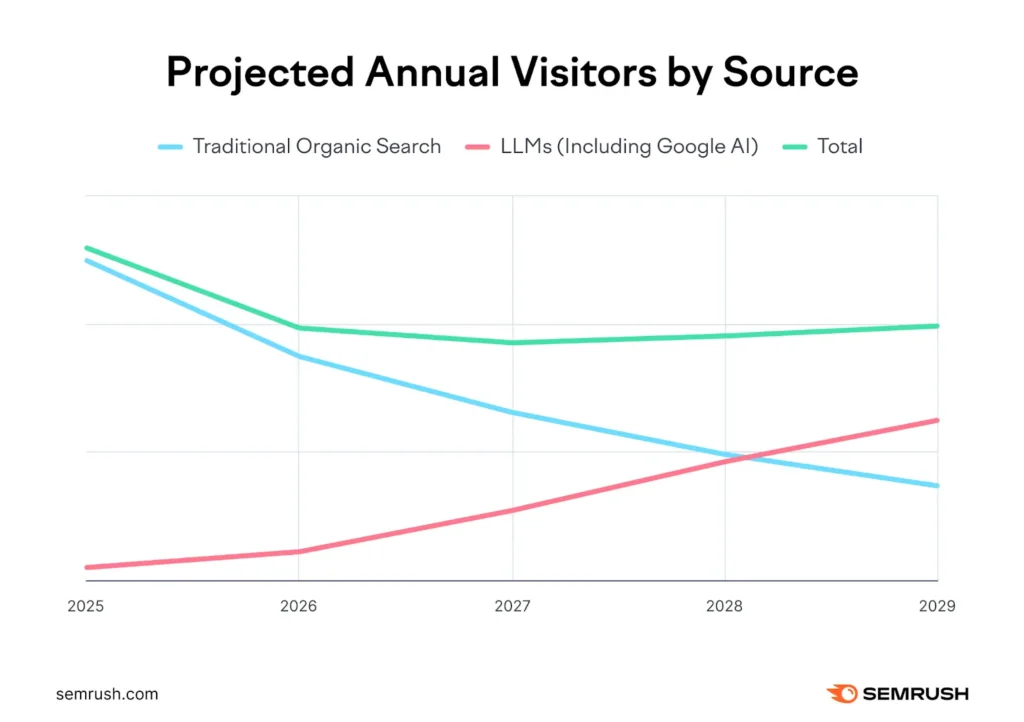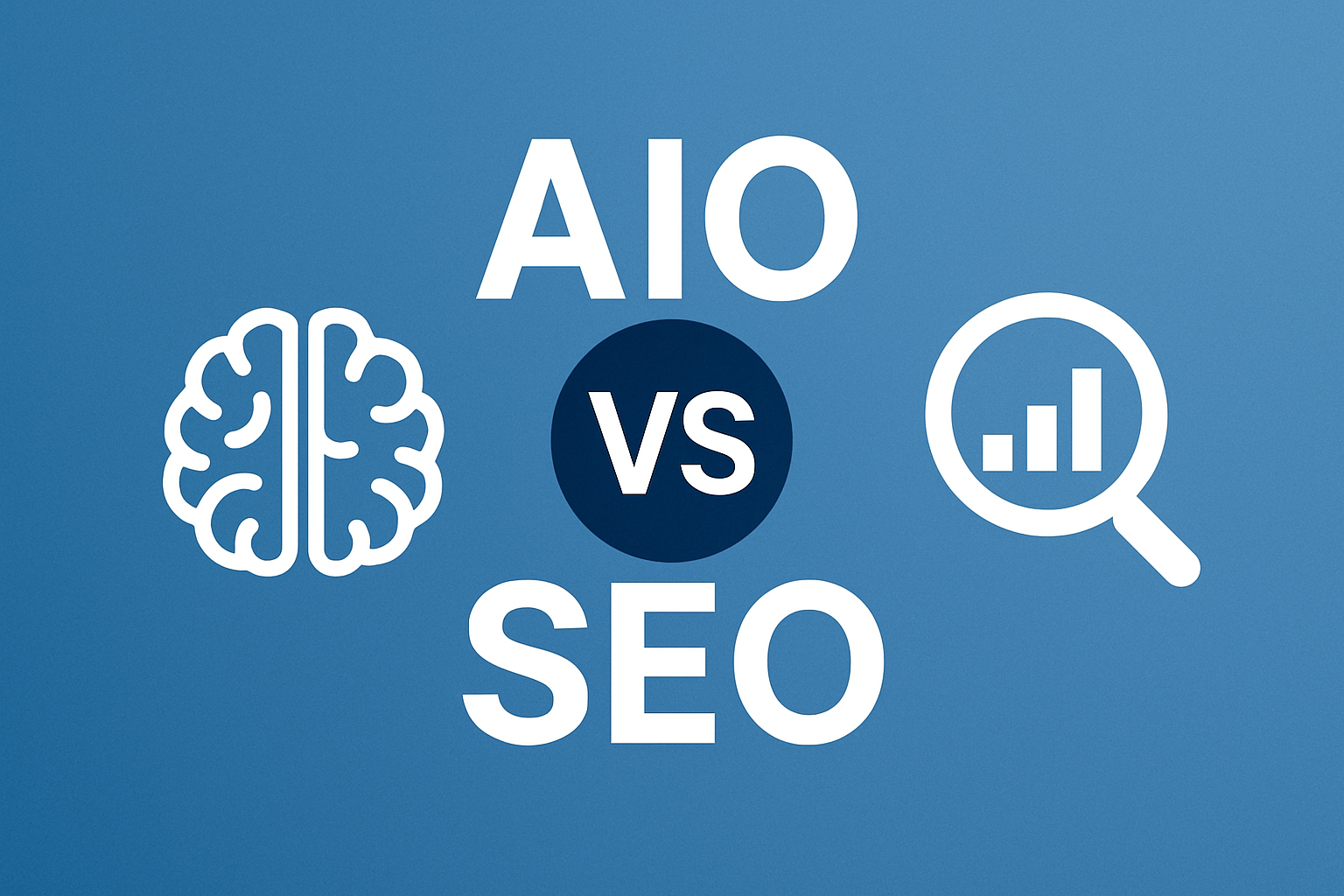While you’ve been perfecting your traditional SEO strategy, AI search engines like ChatGPT, Google’s AI Overviews, Perplexity, and Gemini have quietly become the new gatekeepers of digital discovery.
Here’s the reality: when someone asks “What’s the best project management tool for remote teams?” or “How do I reduce customer churn?”, they’re increasingly getting their answers from AI-powered responses rather than clicking through traditional search results. This shift isn’t just changing how people find information, it’s fundamentally altering how businesses need to approach online visibility.
Understanding the New Search Landscape
Traditional SEO: The Foundation That Still Matters
Search Engine Optimization has been the backbone of digital marketing for over two decades. It’s built around a simple premise: create content that search engines can crawl, index, and rank based on relevance and authority signals. The goal? Land on that coveted first page of Google search results.
Traditional SEO focuses on:
- Keyword optimization and density
- Backlink building and domain authority
- Technical site performance and crawlability
- Content that satisfies search intent
- On-page optimization elements
AIO: The New Frontier of AI-Optimized Search
Artificial Intelligence Optimization (AIO), also known as Generative Engine Optimization (GEO)—represents a paradigm shift. Instead of optimizing for search result rankings, AIO focuses on getting your content featured in AI-generated responses, summaries, and overviews.
When someone queries ChatGPT about “best CRM software for startups,” the AI doesn’t just point them to search results. It synthesizes information from multiple sources and provides a comprehensive answer. The question becomes: will your brand be mentioned in that response?
AIO strategies target:
- AI model training data and knowledge bases
- Structured data that AI can easily parse
- Content formats that AI models prefer to cite
- Entity recognition and knowledge graph optimization
- Context-rich, authoritative content positioning

Key Differences Between SEO and AIO
1. Optimization Target
- SEO: Optimizes for search engine algorithms and human users
- AIO: Optimizes for AI model comprehension and response generation
2. Success Metrics
- SEO: Rankings, organic traffic, click-through rates
- AIO: AI answer inclusion rate, branded query responses, citation frequency
3. Content Approach
- SEO: Keyword-focused content with clear user intent matching
- AIO: Context-rich, entity-focused content that AI models can easily understand and cite
4. Technical Requirements
- SEO: Meta tags, site speed, mobile optimization, structured data
- AIO: Enhanced schema markup, knowledge graph signals, AI-readable content structure
5. Competitive Landscape
- SEO: Competing for 10 blue links on search results
- AIO: Competing for inclusion in a single, comprehensive AI response
How the Industry is Shifting, The Numbers Don’t Lie
The data tells a compelling story about this transformation:
Recent studies show that AI-powered search queries have grown by over 300% in the past year alone. More telling is user behavior: when AI provides a comprehensive answer, users are 40% less likely to click through to traditional search results.
For startups and growth-focused companies, this shift represents both a massive opportunity and a potential threat. Early adopters who master AIO are seeing significant advantages in brand visibility and thought leadership positioning, while companies stuck in traditional SEO approaches are experiencing declining organic reach.
The shift is particularly pronounced in B2B sectors where decision-makers increasingly rely on AI assistants for research, vendor comparisons, and strategic planning. When a potential customer asks an AI about solutions in your space, being featured in that response can be the difference between consideration and invisibility.

Actionable Insights: Your AIO Strategy Playbook
1. Audit Your Current AI Visibility
Start by understanding where you stand in the AI landscape. Query various AI platforms about topics in your industry and see if your brand appears in responses. This baseline assessment reveals both opportunities and gaps in your current approach.
Key questions to explore:
- Does your brand appear when AI discusses your industry?
- Are competitors being cited more frequently?
- What type of information do AI models associate with your brand?
2. Restructure Content for AI Consumption
AI models prefer content that’s well-structured, authoritative, and context-rich. This means moving beyond keyword optimization to create comprehensive, topic-focused content that establishes expertise.
Implementation tactics:
- Create topic clusters around your core expertise areas
- Use clear headings and subheadings that AI can easily parse
- Include relevant statistics, case studies, and expert insights
- Structure content with clear problem-solution frameworks
3. Enhance Your Knowledge Graph Presence
AI models heavily rely on structured knowledge bases. Strengthening your presence in knowledge graphs increases the likelihood of being featured in AI responses.
Action steps:
- Optimize your Google Business Profile and industry directories
- Maintain consistent NAP (Name, Address, Phone) information across all platforms
- Create and maintain Wikipedia entries for notable company milestones or leadership
- Engage with industry publications and secure authoritative mentions
4. Implement Advanced Schema Markup
While traditional SEO uses basic schema markup, AIO requires more sophisticated structured data that helps AI models understand context and relationships.
Advanced schema strategies:
- Use organization and person schema for leadership content
- Implement FAQ schema for common industry questions
- Create product/service schema with detailed specifications
- Use review and rating schema to establish credibility signals
Building Topical Authority in the AI Era
Topical authority remains crucial, but the approach needs refinement for AI optimization. Instead of broad keyword coverage, focus on becoming the definitive source for specific topics within your expertise area.
The Deep Expertise Model
Rather than covering 100 topics superficially, deeply explore 10-15 core topics that align with your business objectives. Create comprehensive content that covers every angle, addresses common questions, and provides unique insights that AI models will find valuable to cite.
Content Depth vs. Breadth Strategy
AI models favor content that demonstrates deep understanding rather than surface-level coverage. This means:
- Creating pillar content pieces that thoroughly explore core topics
- Developing supporting content that addresses subtopics and related questions
- Including original research, data, and expert perspectives
- Updating content regularly to maintain relevance and accuracy
Expert Entity Building
Position key team members as recognized experts in your field. AI models increasingly reference individual experts, not just companies. This involves:
- Publishing thought leadership content under expert bylines
- Participating in industry discussions and conferences
- Contributing to reputable publications and podcasts
- Building recognition through awards and industry acknowledgments
Understanding and Optimizing for Intent in AI Search
AI search operates on a different intent model than traditional search. While traditional SEO focuses on matching specific queries, AI search aims to understand broader intent context and provide comprehensive responses.
The Four Pillars of AI Search Intent
1. Informational Intent Plus: Users don’t just want information, they want synthesized insights that help them make decisions. Your content should provide not just facts, but analysis and recommendations.
2. Comparative Intent: AI users frequently ask for comparisons between solutions, approaches, or strategies. Create content that positions your offerings within broader market contexts.
3. Procedural Intent: Step-by-step guides and how-to content perform exceptionally well in AI responses. Focus on actionable, sequential information that AI can easily structure and present.
4. Predictive Intent: Users increasingly ask AI about trends, future developments, and strategic planning. Content that addresses “what’s next” questions positions you as a forward-thinking authority.
Strategy Overview: Your 90-Day AIO Implementation Plan
Phase 1: Foundation (Days 1-30)
- Conduct AI visibility audit across major platforms
- Identify top 10 topics for authority building
- Audit existing content for AIO optimization opportunities
- Implement basic enhanced schema markup
Phase 2: Content Transformation (Days 31-60)
- Create comprehensive pillar content for priority topics
- Optimize existing high-performing content for AI consumption
- Develop FAQ content targeting voice and AI queries
- Build expert profiles and thought leadership positioning
Phase 3: Advanced Optimization (Days 61-90)
- Implement advanced schema and structured data
- Create AI-friendly content formats (lists, comparisons, step-by-step guides)
- Develop industry partnership and mention strategies
- Launch measurement and tracking systems for AI performance
Measuring Success in the AIO Era
Traditional metrics like rankings and organic traffic remain important, but AIO requires new measurement approaches:
AI-Specific Metrics
- AI Answer Inclusion Rate: Percentage of relevant queries where your brand appears in AI responses
- Branded AI Query Growth: Increase in AI searches specifically mentioning your brand
- Expert Recognition: Frequency of individual team members being cited as experts
- Competitive AI Share: Your visibility compared to competitors in AI responses
Hybrid Metrics
- Total Search Visibility: Combined traditional and AI search presence
- Content Authority Score: Measure of how often your content is referenced across platforms
- Intent Capture Rate: Ability to address user needs across both traditional and AI search
The Competitive Advantage of Early Adoption
Companies that master AIO early are building significant competitive moats. As AI search becomes mainstream, the brands that have established authority and visibility in these channels will be increasingly difficult to displace.
The opportunity is particularly pronounced for startups and growth companies. While enterprise competitors may be slow to adapt their established SEO strategies, agile companies can quickly pivot to capture AI search visibility in their niches.
Looking Ahead: The Future of Search Optimization
The evolution toward AI-dominated search isn’t slowing down. As AI models become more sophisticated and integrated into daily workflows, the importance of AIO will only increase.
Smart companies are already preparing for the next phase: personalized AI assistants that learn individual user preferences and provide highly customized recommendations. The brands that establish authority and trust in current AI systems will be best positioned for this next evolution.
The key is balance. Don’t abandon traditional SEO, it still drives significant traffic and conversions. Instead, evolve your strategy to include AIO as a complementary approach that extends your visibility into the growing AI search ecosystem.
Your Next Steps
The shift from SEO to AIO isn’t just about adopting new tactics, it’s about fundamentally rethinking how you build authority and visibility in a world where AI mediates an increasing portion of information discovery.
Start with an audit of your current AI visibility, identify your top opportunities for authority building, and begin creating content that serves both human readers and AI models. The companies that master this transition will own the conversation in their industries for years to come.
The question isn’t whether AI search will impact your business, it’s whether you’ll be ready when it does.
